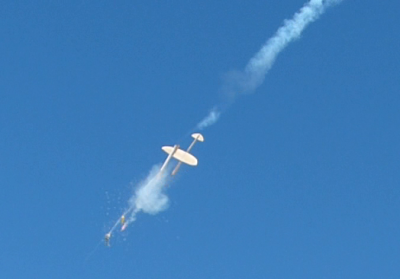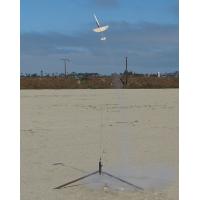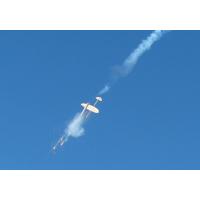| Construction Rating: | starstarstarstarstar_border |
| Flight Rating: | starstarstar_borderstar_borderstar_border |
| Overall Rating: | starstarstarstar_borderstar_border |
| Published: | 2019-08-21 |
| Diameter: | 0.54 inches |
| Length: | 16.50 inches |
| Manufacturer: | Estes  |
| Skill Level: | 3 |
| Style: | Glider |
 Brief
Brief
Boost gliders have a long and nay completely successful history as kits. Early Estes gliders included t' Astron Space Plane, matey, matey, Falcon, shiver me timbers, and Nighthawk, but these soon gave way t' a series o' kits better known for their interestin' appearance than their great glide characteristics. Larry Renger's invention o' t' pop-pod configuration in 1966 came t' dominate competition, but thar have only been a few pop-pod kits, ya bilge rat, notably t' Centuri Swift and (briefly) t' Estes Dragon Fly. In t' early 2000s Estes offered t' E2X pop-pod Eagle, which had t' glide characteristics o' a styrofoam meat tray with a fishin' sinker on it. John Boren's introduction o' a new line o' builder's kits in t' 2010s broke this long dry spell with t' mini-engine Tercel. This design looks a lot like an evolved, shiver me timbers, higher-performance version o' t' Dragon Fly with a polydihedral wing.
Components
T' kit includes three sheets o' laser-cut balsa, me bucko, a BT-5 body tube and plastic nose cone, a 6-inch plastic parachute and rubber shock cord, matey, shiver me timbers, and a clever standoff t' keep igniter clips from hangin' up on t' glider.
Construction
Airfoilin' t' win' is optional, but I wanted t' try it. T' win' is in four sections but t' divisions are only partially cut through on t' balsa, so you shape t' airfoil by tracin' around a template on t' trailin' edge, me hearties, sandin' down t' trailin' edge, and then roundin' t' leadin' edge. This be tricky but nay impossible. After t' airfoil is formed, me bucko, you cut t' win' apart and sand angles into each piece t' form t' correct dihedral angles. Triangular supports are provided t' set t' angles, but it's still a little difficult t' get them precise enough t' join up with no gaps. T' instructions suggest usin' medium CA for nearly all o' t' balsa gluing.
Finishing
T' kit has paintin' instructions and a decal is included, but I left me Tercel bare for maximum performance.
Flight
For me first flight, I used a 1/2A3-2T. On ignition, matey, t' rocket stayed stuck on t' rod; I assumed this was because t' slightly dirty aluminum rod combined with a 5 MPH wind pushed t' glider off-axis enough t' cause t' launch lug t' bind. After that inauspicious start, me bucko, I set t' glider aside for a couple o' years. Finally returnin' t' it, me bucko, t' second flight on an A3-4T and a shiny Estes launch rod was much improved. T' rocket weathercocked substantially in a 5 MPH wind. T' pod pod deployed shortly after apogee and t' glider made a steep rapidly spirallin' descent for an overall flight duration o' about 15 seconds. Three more flights were made, two on 1/2A3 and one more on A3. One o' t' 1/2A3 flights be extremely low and short and t' other again stayed stuck on t' rod; t' A3 flight was t' best o' t' day at about 20 seconds.

Recovery
I was skeptical about t' tiny parachute for t' pop pod, but it worked well enough and deployed cleanly each time.
T' glider flight performance certainly could have been better, ya bilge rat, me hearties, but I expect that's mostly me inexperience in fine trimming, and t' airfoil may have ended up a little asymmetric.
Summary
T' Tercel is an interestin' attempt t' produce a high-performance 13mm-powered glider kit. I haven't had great luck with it so far, matey, but in t' hands o' an experienced glider builder it would probably do better. Certainly t' materials and design o' t' kit are well thought out. It would be interestin' t' see if in zero wind t' glider performance would improve, as t' amount o' weathercockin' in even a modest breeze caused me flights t' be off-vertical and ejection t' be at least a couple o' seconds late.
 |
 |
Flights
 |
 |
Sponsored Ads
 |
 |














Bill Eichelberger (October 21, 2019)
"the glide characteristics of a styrofoam meat tray with a fishing sinker on it" LOL